The Bills should be open-minded about adding help. Scouting reports coming out of Temple suggested that Dawkins might have to kick inside or move to right tackle at the pro level, and it could end up playing out that way. If the Bills see a left tackle prospect they love in the first round of April's draft -- they have the No. 9 pick -- or manage to sign someone like Trent Brown or Donovan Smith, moving Dawkins to right tackle could improve two positions.
As it is, they need to find at least one tackle and one guard, with John Miller and Jordan Mills both free agents. Jeremiah Sirles could fill one of those roles in a pinch, but he's likely better as a sixth or seventh lineman off the bench. Offensive coordinator Brian Daboll spent the 2017 season at Alabama, so it wouldn't be shocking to see the Bills lean toward adding Bama products Jonah Williams in Round 1 or Ross Pierschbacher later in the draft. With the Carolina brain trust of Sean McDermott and Brandon Beane running football operations, former Panthers right tackle Daryl Williams will also likely be on the team's radar.
The bad news is that there really isn't much in the cupboard for quarterback Josh Allen. Undrafted rookie free agent Robert Foster impressed during the second half of the season, as the former Alabama backup racked up 511 receiving yards and three touchdowns over the final seven games. He'll be in the picture for snaps, although it's still way too early to pencil him in as a building block. Zay Jones improved in his second season and dramatically cut down his drops, but the 2017 second-rounder was still one of the least efficient wideouts in football.
It's possible Jones takes a leap forward or someone like Jason Croom harnesses his athleticism and becomes a starting-caliber tight end, but the Bills realistically need to come away from this offseason with a WR1 and a TE1. This isn't a great free-agent market for veteran receivers. They will have to wonder whether it's better to get Allen help at any cost, even if it means paying an exorbitant price for Chargers deep threat Tyrell Williams or former Lions and Eagles wideout Golden Tate. The easy math is to link Buffalo with another former Panthers wideout in Devin Funchess, who looked like a burgeoning star in 2017 before losing his role in Carolina's offense during the second half of 2018.
And again, at tight end, it'll be easy to glance toward Alabama star Irv Smith Jr. in the draft, but I would wonder whether he'll make it to Buffalo at pick No. 40. If the Bills want a veteran tight end, it's basically Jared Cook or bust; they could try to project more production from younger players such as C.J. Uzomah or Jesse James, but the draft is the more logical place to look for tight end help.
Buffalo can hope that a healthy McCoy has a bounce-back season. Even if that happens, though, he is a free agent in 2020, and he doesn't seem to fit Buffalo's rebuilding timeline around Allen. I don't think McCoy would have much trade value given his $6.2 million base salary, and the Bills don't have a real option to replace McCoy if they did move on from their veteran halfback, but they need to start thinking about 2020 options now. Buffalo has two picks in both the fourth and fifth rounds, and it wouldn't surprise me to see the team use at least one of those selections on a running back.
The rebuild should start by moving on from veterans who aren't going to help two or three years down the line. The Dolphins can gain $13 million in cap space by moving on from Andre Branch and Danny Amendola. They can add nearly $13 million more by cutting Robert Quinn, although I'd wait to see if there's some semblance of a trade market for the former Rams star.
It also means letting players leave who aren't going to help Miami's next playoff team. Frank Gore and Cameron Wake can still play, but Gore will be 36 in May and Wake is 37. William Hayes turns 34 this spring. Those guys should pursue a title somewhere else. Ja'Wuan James looked like he was on his way off the roster this time last year, but the 27-year-old had his best season as a pro in 2018. The Dolphins could justify bringing back the free-agent tackle.
Parker's market could be trickier. The 2015 first-round pick is set to play out his fifth-year option at $9.4 million, and while the Dolphins could afford to give him some run in a rebuilding season, it's clear they've grown exhausted of the Louisville product. Parker had his moments again in 2018, notably posting a 134-yard game against the Texans, but he remains injury-prone and inconsistent. He needs a fresh start, but he would need to take a pay cut to have any trade value.
The Dolphins will likely look to the draft for a replacement, but that also will be difficult. Miami has the 13th overall pick, leaving the Dolphins behind teams such as the Raiders, Giants, Jaguars and Broncos, all of whom could be in line to draft a quarterback. There's no guarantee they will end up with the quarterback they want, and while they could trade up to get the passer of their dreams, this roster is in tatters. They need to be amassing extra draft picks, not moving up to grab one player.
The Dolphins should be in no rush to dump Tannehill. If they don't find the passer of their dreams in the draft, they should keep the 30-year-old for another season, given that the only other passers they have in the organization are sixth-rounder Luke Falk and Jake Rudock, who's on a futures deal. (If Miami wants to tank, it can always bench Tannehill midseason.) If the Dolphins land on Kyler Murray or Dwayne Haskins without having to give away a future first-round pick, they can safely move on from Tannehill and save the $18.7 million in base salary they owe him for 2019.
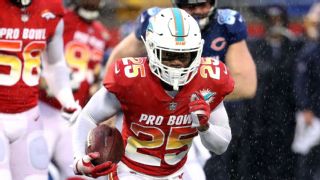
5. Re-sign Xavien Howard. If Tunsil is this team's building block on offense, Howard is the option it can build around on defense. Amid a trio of great corners in the AFC East with Howard, Stephon Gilmore and Tre'Davious White, the best guy in the division shifted from week to week. There were plenty of times it was Howard, who tied for the NFL lead with seven interceptions last season.
The former second-round pick is entering the final year of his rookie deal, and he already has admitted to hearing trade rumors. I don't get it. At 25, Howard still has plenty of years to go in his prime. Even if it takes the Dolphins three years to start looking like a contender, he will still be 28 and should be among the better corners in football. Unless someone wants to give them a franchise-tag-sized haul, Howard should remain in Miami for years to come.
Re-signing Howard could be expensive, but the Dolphins will have room if they start shedding veterans. It's not unreasonable to imagine him looking for something beyond the five-year, $75 million deal Josh Norman signed with Washington in 2016. Norman had a better pedigree when he left the Panthers, but the salary cap has risen from $155.2 million in 2016 to around $190 million in 2019.

New England Patriots
1. Extend Tom Brady's deal. Let's start with an easy one. While Brady has notably taken less money than his peers over the years, his cap hold for 2019 is $27 million, which is the fifth largest in the league. It's also the final year of his deal, so if the future Hall of Famer really wants to play until he's 45, the Pats have some work to do. New England obviously doesn't want Brady to go anywhere, so a two-year extension would keep him around while creating cap room in 2019.
The exact terms of the extension all depend on what sort of discount Brady is willing to take, but the team could easily free up $6 million in space with a Brady deal. It could create another $11.2 million by cutting Dwayne Allen and Adrian Clayborn, which would get the Pats over $31 million in room, pending a possible retirement ...
2. Convince Rob Gronkowski to return (or get a very notable replacement). There's no replacing Gronk. It was telling that when New England finally moved the ball on offense in the Super Bowl, it was by going to 22 personnel and spreading out the Rams' base defense. Few teams in the NFL have tight ends capable of stretching the seams. The Patriots have one in Gronk. Few teams in the NFL have a tight end capable of looking like an extra offensive lineman in the blocking game. That's Gronk, too.
If they can't convince Gronkowski to return, it will free up $9.9 million more in cap room and push them over $40 million. Without Gronkowski, the Pats probably have to change their offensive style. They originally built their Brady offenses around Antowain Smith and Troy Brown before transitioning to the Corey Dillon and Deion Branch era. In 2007, they moved to the spread and imported Randy Moss, Wes Welker and Donte' Stallworth. When it was time to move on from Moss, they drafted Gronkowski and Aaron Hernandez.
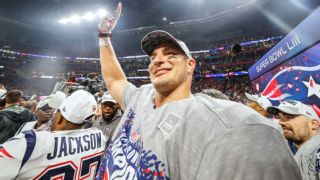
It's possible that the future is heavy doses of Sony Michel and power sets, with the Patriots taking advantage of teams moving toward smaller defenses and using the nickel as their base set. Maybe they'll trade up to grab T.J. Hockenson in Round 1 and turn the Iowa tight end into the next Gronk. I'd be skeptical.
With no Gronk, I wonder whether New England shifts its offense back toward the spread. It needs a great receiver on the outside to pull that off, and it just so happens that two of them might be available via trade this offseason. The Pats have to give serious consideration to trading for either Odell Beckham Jr. or Antonio Brown. Of the two, I would prefer Beckham, who's five years younger. Of course, Beckham also would cost more.
Even if it's not a receiver on the level of Beckham or Brown, expect the team to replace Gronkowski by making at least one meaningful addition to its receiving corps this offseason. It also could add a depth piece given that Phillip Dorsett, Chris Hogan and Cordarrelle Patterson are all free agents. Bill Belichick has tried to sign Emmanuel Sanders in the past, so it wouldn't be surprising if he went after Sanders in the hopes that the Broncos wideout will be ready for the second half of the season.
3. Let Trent Brown leave, and try to bring back Trey Flowers. Everything depends on the price, but New England has a much more obvious need at defensive end than it does at left tackle. Brown wasn't even guaranteed a starting job when he joined the Pats last year, but when first-round pick Isaiah Wynn tore his Achilles, Brown became the starter and excelled. Wynn should be ready for Week 1 next season, and with Marcus Cannon entrenched at right tackle, they probably can't realistically afford to compete with teams who want to pay Brown something in the $13 million range.
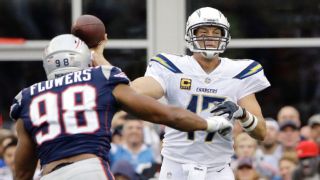
If the Pats lose Flowers, on the other hand, their edge rotation suddenly looks very thin. They could bring back John Simon and hold onto Clayborn in lieu of cutting the former Bucs end, but a Flowers-less team absolutely has to add a starting-caliber end to replace him. I'd argue that the Patriots should consider franchising Flowers, but they've developed a habit of letting their players hit the market before trusting that they'll get a shot at matching an offer. Belichick re-signed Devin McCourty and Dont'a Hightower that way, but it led to an outlandish offer on Nate Solder last year. I'd feel comfortable going to $14 million per year on Flowers, but I wonder whether that will be enough (or if Belichick feels the same way).
4. Add help on the defensive line. Regardless of what happens with Flowers, New England needs to increase its depth up front. Flowers and Simon are free agents on the edge, while Malcom Brown and Danny Shelton are both unrestricted on the interior. I would imagine the team probably has to bring in at least one run-stuffer. One pivot from Flowers would be to sign Ndamukong Suh, who would give Belichick the most impactful interior defender he has had since Vince Wilfork, but you know the Patriots will get somebody on a bargain deal who comes up with a big play in the postseason.
5. Find a punter. Ryan Allen is a free agent, and the Pats have generally been comfortable cycling through left-footed punters; they even brought in options to compete with Allen last offseason. It wouldn't be shocking to see them opt for a new solution. If so, Allen is leaving on a high, given how much work the 28-year-old ran through in Super Bowl LIII.

New York Jets
1. Bring back the special-teams stars. The Jets have a pair of special-teams Pro Bowlers in kicker Jason Myers and return man Andre Roberts, who are both free agents. With more than $100 million in cap space, New York should bring them back. Special-teams performance can be inconsistent from year to year, and I wouldn't count on Myers hitting more than 90 percent of his field goal attempts again in 2019, but what do the Jets have to lose?
They have plenty of other veteran free agents, but I wouldn't be desperate to bring most of them back. Morris Claiborne has been helpful and probably deserves a multiyear deal at this point. Henry Anderson looked good last season, racking up seven sacks and 16 quarterback knockdowns, but he might be a better fit in a 3-4 defense and hadn't been able to stay healthy before 2018. Josh McCown helped mentor Sam Darnold, but it might better to try to bring back the veteran passer as a coach as opposed to putting him in the line of fire under center.
Restricted free-agent wideout Robby Anderson will be a difficult situation to parse. I would imagine the Jets will tender Anderson at the second-round level, given the original-tender level would allow no compensation for the former undrafted free agent.
Do they want to commit to Anderson in the long term? Anderson has shown flashes where he looked like a viable starting wideout -- including 20 catches for 312 yards and three scores over a three-game stretch in December -- but the 25-year-old also can go missing for weeks at a time and has gone through myriad off-field issues during his career. The Jets also signed Quincy Enunwa to a four-year, $36 million extension off the strength of a season in which he averaged 40.8 receiving yards per game, which might have tipped their hand. I would wait to see what Anderson does in 2019 before making a decision.

2. Pick up Darron Lee's fifth-year option. The 2016 first-rounder had a rough couple of years to start his career, but 2018 was his best season as a pro. The Jets already are invested in one inside linebacker after signing Avery Williamson last offseason, and Lee was suspended for the final four games of the season after violating the NFL's substance abuse policy, but his fifth-year option seems relatively low-risk. The team also should be able to void Lee's guaranteed salary for 2019 and cut him if it wants to go in the opposite direction.
3. Sign Matt Paradis and upgrade the line. The Jets already cut Spencer Long after one season. James Carpenter is a free agent. They should be set at the other three spots with Kelvin Beachum and Brandon Shell at the tackles and Brian Winters at right guard, but they need to add help for Darnold on the interior.
If they're going after significant help, Paradis would be the most logical option. The only concern is that the 29-year-old center is coming off a fractured fibula, but while the injury cost Paradis the second half of the 2018 season, he should be healthy for Week 1 in 2019. New York also could make a run at Rodger Saffold if it wants to upgrade at guard, and it wouldn't be horrible if it tried to sign the two best interior linemen on the market given its cap space. Upgrading in the draft also makes sense.
4. Add a running back who isn't Le'Veon Bell. I think the Jets will end up with Bell, if only because all the pieces fit. They need a running back with Bilal Powell a free agent and Isaiah Crowell posting the second-worst success rate in football last season. They have nine figures of cap space and a general manager who is likely going to lose his job if they don't show serious signs of improvement next season. Gang Green plays in a huge media market and has antagonized fans by selling tickets without personal seat licenses in sections where fans previously had to pay for PSLs, leading to a 2018 lawsuit. Bell wins the offseason away from the Giants in a city where that matters.
There just isn't much evidence that the Steelers really missed Bell last season. In 2017, he averaged 4.0 yards per carry and converted 23.1 percent of his carries into first downs. Last season, James Conner replaced Bell and averaged 4.5 yards per carry while turning 26 percent of his runs into first downs. Bell offered more as a receiver, of course, but the idea that he's a No. 2 wideout isn't realistic.
The Steelers threw the ball more frequently and turned the ball over more often, but they jumped from eighth in points per game in 2017 to sixth last season. They fell from third to sixth in offensive DVOA, but both moves are well within the random variance between years we would see from teams who don't make any changes at all. It's very difficult to make a case that the Steelers were notably worse when replacing Bell with a midround draft pick.
That's the performance argument, and it's even before addressing Bell's track record of missing time, either via injury or suspension. Bell missed 18 games during his first five seasons in the league, which doesn't include his full-season holdout in 2018. One of those games was a Week 17 respite, but Bell also missed Pittsburgh's postseason games in 2014 and 2015. Availability is a legitimate concern with Bell.
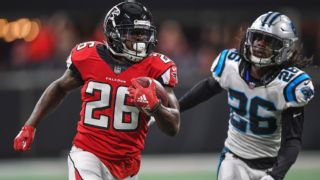
At the right price, the Jets should be interested in Bell, but that number shouldn't be anywhere near the $15 million annual average salary that has come up over the past couple of seasons. The Jets could very well justify adding a back, but they're much better off going for a lower-cost option like Tevin Coleman or Spencer Ware.
5. Trade down in the first round. The Jets have the No. 3 overall pick in the draft and need help in their front seven to supplement star end Leonard Williams. At that third spot, they're assured of adding either massive Alabama tackle Quinnen Williams, who might be the best player in the draft independent of position, or one of a pair of edge rushers in Nick Bosa and Josh Allen. Nobody would fault the Jets for taking any of those three players.
I don't think it's the best move, though, especially in a draft full of front-seven talent. New York needs extra picks, especially after trading its first-rounder and three second-rounders to get the third overall pick and draft Darnold last year. One of those second-rounders is the 34th pick in this year's draft, which is going to the Colts.
There's also a lack of homegrown talent on this roster. Assuming Powell and Dakota Dozier leave this offseason, the Jets will have three players left from their six drafts between 2010 and 2015: Winters, Enunwa and Leonard Williams. They have a lot of cap room, but they can't build this entire team upon free agents and undrafted guys.
At pick No. 3, the Jets are also in a great spot to market to teams looking to grab a quarterback like Dwayne Haskins, given that they pick ahead of the Raiders (No. 4), Giants (No. 6), and Jaguars (No. 7). The Cardinals and 49ers aren't taking a quarterback at pick Nos. 1 and 2, respectively, and while they could both consider trading down from their perches, the Jets could have a real opportunity when their pick pops up on April 25 in Nashville, Tennessee. They should be actively creating a market for their selection, and if Haskins (or Kyler Murray) is still on the board at 3, the Jets should trade their pick to the highest bidder.
AFC NORTH
Let's move on to the AFC North, where the Browns are having the most stable offseason for the first time in, oh, 30 years or so. The Ravens are replacing general manager Ozzie Newsome and just traded Joe Flacco, the Bengals still haven't found a defensive coordinator, and the Steelers are dealing with a miffed wide receiver. You might have heard.
Let's begin in Baltimore, where new GM Eric DeCosta has work to do ...

Baltimore Ravens
1. Re-sign C.J. Mosley and make tough choices at linebacker. Mosley has made four Pro Bowls over his first five seasons in Baltimore and has missed only three games. About the worst thing you could say about the Alabama product is that he isn't Ray Lewis, but that's an unfair bar, even for a Ravens inside linebacker. Eleven linebackers since 1970 who are Hall of Fame-eligible made it to at least four Pro Bowls in five seasons. Seven of those guys went to Canton, and when they become eligible, Patrick Willis and DeMarcus Ware will join the list. Mosley is in good company.
Could the Ravens use the franchise tag on Mosley? Yes, but it wouldn't be ideal. The league has only one franchise tag for linebackers, and because pass-rushing outside linebackers make so much more than inside linebackers, it serves to essentially rule out franchising interior linebackers. The tag for 2019 is projected to come in at $15.5 million per season, but there are only two inside linebackers in the league -- Jamie Collins and Luke Kuechly -- who have multiyear deals for more than $12 million annually.
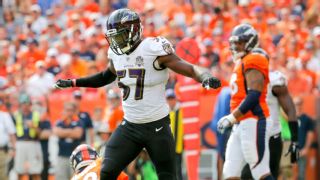
Mosley should be in line for a huge deal. One year after an offseason in which Anthony Hitchens got five years and $45 million in free agency and Eric Kendricks picked up five years and $50 million before entering the final year of his contract, the Ravens are looking at something closer to $13 million per season for Mosley. Even given that inside linebackers generally don't get paid huge money, I don't see how you can let a player like him leave.
Signing Mosley could mean the Ravens will have to let edge rusher Za'Darius Smith leave in free agency, but I might be more willing to consider that possibility. Smith had a career year and led the team in both sacks (8.5) and knockdowns (25), but the 26-year-old racked up a total of 10 sacks over his first three NFL seasons.
Smith's 16 knockdowns in 2017 hinted at a possible breakout in 2018, and he's probably going to be a useful pass-rusher elsewhere, but his situation is a little reminiscent of Pernell McPhee. The similarly sized Ravens pass-rusher racked up 9.5 sacks over his first three seasons, then posted a 7.5-sack, 26-knockdown season in his contract year in 2014. The Bears signed McPhee to a five-year, $38.8 million deal in 2015, but injuries dragged down McPhee's career in Chicago, and the Ravens didn't skip a beat without him.
Those teams had Terrell Suggs, of course, and the future Hall of Famer is set to be a free agent after 16 seasons with the Ravens. Suggs has suggested he wants to play in 2019, so the ball is in Baltimore's court.
Suggs played 71.9 percent of Baltimore's snaps last season and racked up seven sacks, so he can still go. This is a great draft class for edge rushers, so the Ravens might use a pick or two on drafting Suggs' eventual replacement. They should still bring back T-Sizzle on a one-year deal in the $5 million range.
2. Tender Michael Pierce and Patrick Onwuasor, and work on a deal with Matt Judon. Pierce and Onwuasor, both restricted free agents, are going to attract attention from other teams. Baltimore will likely place second-round tenders on them, although it might even be tempted to place a first-rounder on the 340-pound Pierce, who is a valuable part of their defensive line rotation. DeCosta also has to think about a new deal for Judon, who is entering the final year of his rookie deal in 2019.
Much of what happens with these three young defenders could depend on what else goes down this offseason. Onwuasor was a college safety who has successfully converted to inside linebacker, and he flashed with big plays throughout the year before winning Defensive Player of the Week in Week 16. If the Ravens re-sign Mosley, they'll probably let Onwuasor move on after this season and go forward with Mosley and 2018 second-rounder Kenny Young on the interior; if Mosley leaves, they will have to give re-signing Onwuasor more thought.
Likewise, on the edge, the Ravens probably have to choose between Smith and Judon given their spending elsewhere on defense. I'd lean toward the latter, who has been more consistently productive throughout his career. Judon has 19 sacks and 49 knockdowns through three seasons, along with 10 tackles for loss against the run over the past two seasons. Smith had two over that same time frame.
Pierce, meanwhile, could be subject to other moves. Baltimore gave nose tackle Brandon Williams a five-year, $52.5 million deal in March 2017, which is a huge contract for someone who rarely gets after the quarterback. Defensive end Brent Urban just completed his best season as a pro and is now a free agent, and the Ravens might choose to lock him up instead. Pierce is a valuable player, but the Ravens probably can't pay Williams and Pierce what they're worth at the same time.
3. Extend Justin Tucker. It's difficult to imagine the Ravens without their star kicker, who has spent his career bailing out below-average offenses with field goal after field goal. To say that Tucker has been the league's best kicker since entering the NFL sells things short. By Football Outsiders' special teams statistics, which adjust for kick distance and game location, the top-ranked Ravens have been so dominant on points of field position gained by scoring kicks since 2012 (86.1) that the second-place Patriots (43.7) are closer to 16th than they are to first.
Baltimore could move on from Tucker and trust that it can find the next guy as an undrafted free agent, but with a young quarterback in Lamar Jackson, Tucker is going to give the team a valuable safety net for years to come. The Ravens could wait until next season and then use the franchise tag to help negotiate, but Baltimore might end up using the tag to keep around one of their free-agent defenders. A new Tucker deal should reset the kicker market at somewhere around $6 million per season. Imagine what the Bucs or Chargers would be willing to pay for Tucker if he hit the free market.
4. Cut one veteran cornerback. The Ravens are set at one spot with Marlon Humphrey, who took a huge step forward in his second pro season. Their other cornerbacks are in question. After trading Flacco, Baltimore's largest cap hit belongs to Jimmy Smith, who missed nine games combined in 2016 and '17 with injuries before sitting out the first four games of 2018 with a suspension. The 30-year-old has a $15.9 million cap hit, the second largest for any corner in football, and the team could free up $9.5 million in room by cutting the 2011 first-round pick.
Likewise, Baltimore has to decide whether it wants to pick up the 2019 option for 32-year-old Brandon Carr, which carries a $7 million cap hit. He played 84.6 percent of the defensive snaps last season, but Humphrey and Smith were Baltimore's top two corners by the time the team got to the postseason.
This might come down to whether the Ravens can convince Smith to take a pay cut. The Colorado product has a $9.5 million base salary in the final year of his deal, and while he would attract interest on the free-agent market, I don't think any team would give Smith that sort of money. If they can extend Smith for a couple of years and bring down his overall compensation to a cap hit in the $10 million range, they would be smart to keep Smith and move on from Carr. At their current cap hits, I think Baltimore would part ways with Smith and keep Carr.
The Ravens could also theoretically cut 34-year-old safety Eric Weddle, who is entering the final year of his four-year, $26 million deal, but Weddle's experience and instincts still make him a valuable defender. It wouldn't be a surprise to see Baltimore draft a free safety in April to take over for Weddle in 2020.
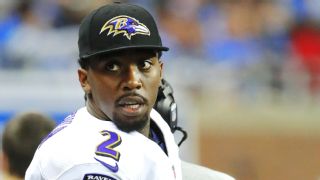
5. Sign Tyrod Taylor. Taylor makes all the sense in the world as the backup for Jackson, given that Baltimore's sixth-round pick in the 2011 draft had his most significant pro success as the starting quarterback under current Ravens offensive coordinator Greg Roman when the two were in Buffalo. Taylor already knows Baltimore's offense, and if Jackson were to get hurt, the Virginia Tech product could step in without skipping a beat.

Cincinnati Bengals
1. Hire a defensive coordinator. While new coach Zac Taylor doesn't seem particularly concerned that candidates such as Todd Grantham and Jeff Hafley have decided to stay in school, the Bengals might be heading all the way to the combine without a defensive coordinator. Teams with established defensive minds as head coaches such as the Patriots have gone for stretches of time without a defensive coordinator, but Taylor has been an offensive coach his entire career. The Bengals have to hire somebody and figure out what their defensive identity is going to be in 2019 sooner rather than later. Note: Cincinnati has hired Giants defensive backs coach Lou Anarumo as its defensive coordinator.
2. Pick up William Jackson's fifth-year option. Jackson wasn't quite the revelation he was during the 2017 campaign, but he's comfortably Cincinnati's best cornerback and is likely to be extended next offseason.
3. Cut Vontaze Burfict. The Arizona State product hasn't played a full 16-game season in five years, having missed 37 of Cincinnati's 80 games thanks to various injuries and suspensions. Burfict isn't playing at a high level when healthy, and his propensity for inexplicably dirty play makes him a liability to cost his team a stop on every single series. The end of the Marvin Lewis era should make for a good time to end Burfict's run in Cincinnati, too.
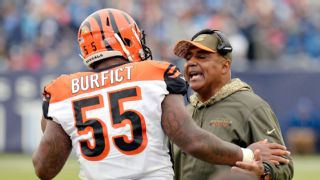
4. Address right tackle and tight end. The Bengals might have thought they had these positions figured out at one point with Cedric Ogbuehi and Tyler Eifert, but Ogbuehi never played like a competent NFL lineman, and Eifert wasn't able to stay healthy. Both are free agents and unlikely to return, as are replacements Bobby Hart, Tyler Kroft and C.J. Uzomah.
This is where I would start running down free-agent possibilities, but the Bengals aren't going to meaningfully invest in unrestricted free agency, so it's not worth wasting your time. They are going to add players via the draft and through the occasional low-cost free-agent addition, because that's what they've done for years. It's possible that things will change under Taylor, but I suspect this is a call by owner Mike Brown.
5. Extend A.J. Green. One thing the Bengals generally do is retain their top homegrown talent, and Green is on pace to become one of the best draft picks in franchise history. The former Georgia star played just 17 snaps during the second half of the season because of a toe injury, but if the Bengals are too cheap to give the 30-year-old Green an extension, they shouldn't bother showing up to play after 2019.
Finding the right terms on a Green extension, however, could be interesting. Green is forever linked to 2011 classmate Julio Jones, who was chosen by the Falcons two picks after Cincinnati chose Green. When the two started to negotiate extensions in 2015, both organizations seemed to wait for the other to make a move. Finally at the end of August, Jones signed a five-year, $71.3 million deal with $47 million due over Years 1-3. Two weeks later, Green inked a four-year, $60 million extension that netted him $47.3 million over Years 1-3. Those two numbers might be related.
Jones still has two years left on his deal, but the Falcons have suggested they're going to break from their usual protocol and give Jones a new contract this offseason. That sets up for another offseason stare-down. We know both Green and Jones are going to get paid; it wouldn't be a surprise to see them both top the five-year, $90 million extension Odell Beckham Jr. signed with the Giants last offseason. The question is who signs first, because whoever doesn't blink is going to pick up a little bit of extra cash for their patience.

Cleveland Browns
1. Lock up Damarious Randall and Joe Schobert. The Browns don't have any free agents who would justify the franchise tag, but they have a pair of key contributors hitting free agency next season in Randall and Schobert, two building blocks for the defense. They're both every-down contributors when healthy, and with $78.6 million in cap space, there's no reason for GM John Dorsey to delay locking up the heart of his defense for years to come.
If the Browns want to clear up cash, they could cut Jamie Collins, who doesn't play in nickel packages when Schobert and Christian Kirksey are healthy. Releasing Collins would save $10.5 million in cash and create $9.3 million in cap space. The Browns could insert Genard Avery, who flashed as a fifth-round pick, into the starting lineup for Collins.
2. Go after Trent Brown. After losing future Hall of Famer Joe Thomas to retirement, the Browns started the year with undrafted free agent Desmond Harrison at left tackle. Harrison struggled during the first half of the season, was scratched with an illness before Week 9, and didn't play another snap the rest of the way. They turned to former Rams tackle Greg Robinson, who delivered the best half-year of his pro career. Stats LLC suggests he didn't allow a single sack in his eight starts, although the 2014 second overall pick did commit six holding penalties.
Should the Browns bring back Robinson? Sure, if the price is right. Should they stop there? Absolutely not. They have the cap space to go after the best tackle on the market, and that's Brown, the Patriots left tackle who was impressive in his first season on the left side after starting his career as a right tackle for the 49ers. The 6-foot-8, 380-pound Brown certainly has the size to play on the blind side, and if Cleveland is going to invest serious money anywhere, left tackle makes the most sense. Dorsey, who used his first selection as a GM to draft Eric Fisher with the first overall pick for the Chiefs, isn't going to ignore the line.

3. Add another edge rusher. The Browns have an absolute stud in Myles Garrett. After that, things get murkier. Larry Ogunjobi has flashed as a promising interior disruptor, although he slowed down as last season went on. Avery racked up 4.5 sacks and 14 quarterback knockdowns, but nobody else topped four sacks or eight knockdowns last season. Emmanuel Ogbah looked like he might be a future difference-maker as a rookie, but the 2016 second-rounder has just seven sacks and 13 knockdowns over 24 subsequent starts, missing time with a broken foot and an ankle injury.
The Browns could use a second pass-rusher to play across from Garrett and scare opposing offensive coordinators. I think the Chiefs are likely to cut Justin Houston, and it might make sense for him to be reunited with Dorsey, even if new defensive coordinator Steve Wilks will be running a 4-3 as his base defense in Cleveland. The Browns ranked 25th against the run last season, so they might also look for a solid two-way veteran like Brandon Graham of the Eagles. Dorsey has four top-100 picks in a draft full of edge help, so it wouldn't shock me if the team invested one of its top selections in a defensive end.
4. Find help next to Ogunjobi. I want the Browns to sign Ndamukong Suh. They need someone who can punish opposing teams for doubling Garrett and have $71 million in cap space. Suh is 32, but the Nebraska product hasn't missed a game to injury in his career. He has been a steady interior presence, and this might be his last chance at getting a multiyear deal. A three-year, $45 million deal with $30 million in guarantees could make both sides happy. Also, it would make me happy.
5. Sign a deep threat. The core of Baker Mayfield's receiving corps is set with Jarvis Landry and David Njoku. Antonio Callaway fell in the draft because of many serious off-field concerns, but he appeared to stay on the straight and narrow during his rookie season. The 21-year-old was stretched as a No. 2 wideout in 2019, and while he still has plenty of time to develop, the Browns started to carve out a role in the second half for Ravens castoff Breshad Perriman, whose speed stretched opposing defenses.
Cleveland could choose to bring back the free-agent Perriman, but it has room to upgrade and find a more consistent deep threat to serve as a contrast to Landry's short and intermediate work. Dorsey traded a draft pick to the Dolphins to acquire Landry, and you wonder whether he might go back to Miami to make a move for Kenny Stills, who wouldn't have much utility on a rebuilding Dolphins team. Cleveland also could make a move in free agency for John Brown, who was impressive in the first half with the Ravens in 2018.

Pittsburgh Steelers
1. Trade Antonio Brown for talent that will help the team now. Whew. Let's get started. When the Brown trade rumors started after the end of the regular season, I looked at the money and pointed out that a trade didn't make sense from Pittsburgh's perspective. The Steelers would save cash by trading away Brown, but $12 million shouldn't matter to a multibillion-dollar business.
The simple math, essentially, is this: Pittsburgh will owe a minimum of $21.1 million on its cap for Brown in 2019. The calculus for the cap hit changes depending on what it does:
Cut or trade Brown before March 17: $21.1 million
Keep Brown: $22.2 million
Cut or trade Brown between March 17 and June 1: $23.6 million
Cut or trade Brown after June 1: $9.5 million in 2019, $14.1 million in 2020 (total of $23.6 million)
These numbers are all within $2.5 million of one another. Under these circumstances -- a player as talented as Brown, still well within the prime (if not the peak) of his career, playing for a team that doesn't have a huge salary-cap problem -- teams simply don't part ways with superstars, certainly not when the difference between them playing and leaving amounts to less than 1.5 percent of the salary cap.
And then Brown went on Twitter. It was one thing when it looked like the Steelers were merely sick of his antics; now it's quite clear he's sick of Pittsburgh, too. I still think the best move for all parties is to work out things, but the chances of that happening seem to fluctuate wildly from week to week.
Even given his social media chatter, Brown is going to have significant trade value. He's on a three-year, $38.9 million deal, and while he might want his new team to guarantee some of that money, just under $13 million per season is a bargain for someone with his talent. The Steelers could justifiably ask for a late first-round pick (or similar value via a pick swap) in return for Brown, although the public discontent between the two sides has unquestionably reduced Pittsburgh's leverage.

Where should the Steelers send Brown? If the Pittsburgh brain trust really believes he is disruptive and going to hurt the chemistry of his new team, the Steelers should be happy to send him within their division. In reality, they know that Brown's talents outweigh his occasional attitude issues, which is why GM Kevin Colbert will want to deal him outside the AFC North. I don't think the Steelers should send Brown to the Patriots for reasons I would imagine to be obvious.
Instead, if the Steelers are going to trade Brown, they need to focus on acquiring young talent that is going to help them in the next two to three years, during what would presumably be the final seasons of Ben Roethlisberger's career. They could use a first-round pick to target Roethlisberger's replacement -- there's also a particularly juicy idea of trading Brown to the Cardinals for Josh Rosen and a midround pick, with the Cardinals then using the first overall pick on Kyler Murray -- but one of the reasons to keep Brown was to try to maximize Pittsburgh's chances of winning one more Super Bowl during the tail end of Roethlisberger's career.
Pittsburgh's biggest need is at cornerback, which leaves it with a few teams that might make sense. The Bills need wideout help for Josh Allen and have Tre'Davious White, who is a genuine star at corner, but the Bills would rightly want more for a cornerback who is still just 24. The Dolphins have Xavien Howard, who said he had been the subject of trade talk, but a rebuilding Miami team has no need for a 30-year-old wideout. The Titans are three-deep at corner with Adoree' Jackson, Logan Ryan and Malcolm Butler, but Butler hasn't looked like his old self since 2016, and Ryan is in the final year of his contract. The Broncos could dangle Chris Harris Jr., but the 29-year-old corner is entering the final year of his deal, too. And that's just the AFC.
In lieu of merely looking for draft picks, the Steelers should try to get a starting cornerback and/or a young wideout as part of a Brown package.
2. Don't tag Le'Veon Bell. Isn't it incredible that Bell has essentially become an afterthought in light of the Brown story? The Steelers have seemingly gone back and forth on using the transition tag to temporarily keep their star running back, only for Colbert to announce on Wednesday that the Steelers will not use a tag and will let Bell hit unrestricted free agency.
It's the right move. We originally figured that the Steelers were going to let Bell leave without a transition tag because it would make Bell eligible for the compensatory formula; if the Steelers didn't make any major signings in free agency, losing Bell would have likely netted them a third-round compensatory pick in the 2020 draft.

Putting the transition tag on him would only make sense, then, if the Steelers didn't think they were going to get a compensatory pick. It would stand to reason that they would put the transition tag on Bell because they expect to be players in free agency and sign someone whose price tag would cancel out the compensatory pick for Bell. Colbert's comment that the team "can't afford" to use the tag suggests they won't be going heavily into free agency, which is in line with what they typically do.
3. Add a cornerback. Corner was a mess for this team in 2018. Joe Haden was sound on one side, and Mike Hilton is a competent slot corner, but former first-round pick Artie Burns was a disaster from Week 1 on before being benched in Week 6. He played just 12 defensive snaps over the final 10 games of the season. The Steelers have a tough decision coming with Burns' fifth-year option, and while I think it makes sense to pick it up, this is the same organization that just had to pay Ryan Shazier's fifth-year option for a season in which the star linebacker wasn't physically able to play.
The Steelers will have to decide whether they want to move forward with Burns. Coty Sensabaugh filled in as the starter, and Pittsburgh gave a handful of snaps per game to 2017 third-rounder Cameron Sutton, although he also sat out most of the second half of the season. Sensabaugh is a free agent, and they can upgrade on him if they don't want to hand the job back to Burns.
I pitched a Burns-for-Trae Waynes trade in the Vikings offseason section, and I think that could make sense for both sides. Using Burns as possible trade bait for a veteran cornerback is plausible, although the Steelers could also keep Burns and sign a free agent to compete with him. Pittsburgh could be in for Jimmy Smith if the Ravens make their veteran corner a cap casualty, and the top of the free-agent market will have cornerbacks such as Bradley Roby, Kareem Jackson and Ronald Darby. Pittsburgh would probably prefer to target someone who is cut, like Smith, to keep intact its compensatory pick for Bell.
4. Extend Roethlisberger. He is in the final year of his extension, and just as is the case with Philip Rivers, it looks like the 36-year-old has a couple of seasons left playing at a high level. I suggested that the Chargers give Rivers a two-year, $54 million deal, and Roethlisberger's new deal should be in the same ballpark.
5. Add help at inside linebacker. With Shazier's future still uncertain, Pittsburgh struggled to find a solution to stop opposing passing games last season. The likes of Jon Bostic and L.J. Fort weren't able to hold up, as the defense ranked 31st in DVOA against throws to tight ends last season. Vince Williams will stick at one spot, but the Steelers desperately need to add somebody with the range to cover players like Travis Kelce in 2019.
They could draft an inside linebacker early in April. They also might pursue an option in free agency. The idea of Pittsburgh stealing away C.J. Mosley from the Ravens in free agency is tantalizing, although it's more likely the Steelers would target someone like Sean Lee, who is likely to be released by the Cowboys. Since Lee would become available after being cut by his team, the two-time Pro Bowler wouldn't impact the compensatory pick formula.
AFC SOUTH
The AFC South sent two teams to the playoffs in 2018, but unless you were particularly fond of underlying metrics, you might have been surprised to see that the Houston Texans and Indianapolis Colts were those teams.
Of course, the Jacksonville Jaguars also were an advanced numbers darling before last season, and they collapsed, so can the Jags rise atop the AFC South again? Let's run through the moves each of these four teams might make in a suddenly competitive division.

Houston Texans
1. Franchise Jadeveon Clowney. The Texans don't want to lose Clowney, nor should they. The 2014 No. 1 overall pick has made it to three consecutive Pro Bowls and just turned 26. He has completed only one full 16-game season as a pro, but the microfracture surgery on his right knee that cost the South Carolina product most of his rookie season hasn't been a problem since. Clowney has missed six games over the past four seasons, undergoing two subsequent arthroscopic surgeries on his other knee.
At the same time, the 6-foot-5, 255-pound Clowney hasn't yet put together the sort of massive season that seems natural for a defender who looks as dominant on the football field as he is. Fifty different defenders have racked up at least one double-digit sack campaign since the beginning of the 2014 season, but Clowney isn't one of them.
He has come close in each of the past two seasons, hitting 9.5 sacks in 2017 and getting to nine last season. But on his game, he looks like the sort of defender who should be annually flirting with Defensive Player of the Year honors. His knockdown totals don't suggest a player who has been trading in bad luck, either. Using the 45 percent rule, Clowney's 67 knockdowns over the past four seasons imply he should have racked up about 30 sacks over that time frame. He has recorded 29.
I'm not saying this to disparage Clowney. I would hardly be surprised if he put together a 15-sack season in 2019. Nobody would be. I bring this up to illustrate how difficult his contract negotiations might be. Edge rushers are paid to rack up sacks, and Clowney's 29 sacks rank 27th over the past four seasons. The Texans might very well point to his production as closer to good than great and suggest he's worth something below the five-year, $72 million extension that Danielle Hunter signed last year. (Hunter, for what it's worth, has 40 sacks over those four years.)
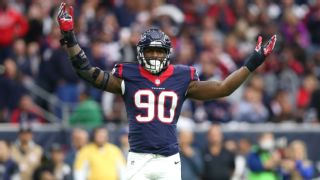
On the open market, though, Clowney would get to negotiate with 31 teams. At least one of those teams would be willing to take the plunge and pay him on his potential, expecting him to put up those 15-sack seasons his tape hints toward. On the open market, Clowney might get something closer to a five-year, $100 million deal with $60 million in guarantees, which would top every other edge rusher contract in the NFL short of Khalil Mack. You can bet Clowney's representation knows this. The Texans have to negotiate against that possibility. Going year to year with Clowney with franchise tags would cost the Texans around $68 million over the next three years, so there's no savings there, either.
The Texans will start with a franchise tag north of $17 million in 2019 and go from there. I think they'll eventually come to terms on an extension, if only because a long-term deal makes sense for both sides. This is going to be a more difficult negotiation than most other franchise tag extensions.
2. Re-sign Tyrann Mathieu. Mathieu's one-year, $7 million deal was a victory for both sides, as Mathieu stayed healthy and produced his best season since his All-Pro campaign in 2015. He was a consistent producer in a Texans secondary that struggled for steady play at cornerback last season, and while his 2015 performance might loom as an outlier, Mathieu's range and instincts make him a valuable free safety.
The 26-year-old Mathieu has suggested he wants to return to the Texans, and a new deal makes sense for both sides. In a market full of free safety options after a season when the league seemed to punt on the position, Mathieu might understandably prefer to lock up long-term stability in Houston. A three-year, $30 million deal could make sense for both parties.
3. Clean up the cornerback position. The Texans have thrown plenty of assets at corners, but things haven't quite worked out the way they planned. Kareem Jackson, a first-round pick in 2010 who spent eight years at cornerback, moved to safety last season to replace Andre Hal, who was battling leukemia. Jackson is a free agent. Kevin Johnson, a 2015 first-rounder, hasn't been able to stay healthy, and he missed 15 games in 2018 while dealing with the aftereffects of a pair of concussions. The Texans have a $9.1 million fifth-year option for him in 2019 that is guaranteed for injury, and it's unclear whether the Wake Forest product will be able to pass a physical. A failed physical would trigger that guarantee.
The Texans drafted Johnson with the hopes that he would eventually take over for Johnathan Joseph, who started 14 games at age 34 and is under contract for $4.8 million in 2019. When Johnson got hurt in 2016, the Texans promoted A.J. Bouye, who excelled in a starting role. The Jaguars signed Bouye to a five-year, $67.5 million deal in free agency in 2017, and the Texans responded by signing Jags slot corner Aaron Colvin to a four-year, $34 million contract last year.
After one year, it's hard to think of many significant free-agent deals that look worse than Colvin's. He missed six weeks with an ankle injury, but even after returning to health, the Texans seemed to sour on their new acquisition. Colvin played just 112 defensive snaps over the final six weeks of the season, 60 of which came in one game, when the Texans benched midseason addition Shareece Wright. Houston restored Wright to the lineup the following week in favor of Colvin, who was a healthy scratch in the wild-card loss to the Colts. Indy subsequently picked on Wright during the game, with Dontrelle Inman beating him for a 21-yard touchdown.
The Texans are probably locked into bringing back Colvin. The 27-year-old has a $8.6 million cap hit in 2019, and Houston would owe $10.5 million in dead money if it cuts him. Even if the Texans designated Colvin as a post-June 1 release, they would owe $8.5 million in dead money on their cap in 2019 and $2 million next year. Given their cornerback depth chart is Joseph and a series of question marks, the Texans likely will hope they can recoup something out of their investment in 2019. They'll also need to address the position in free agency or the draft.

4. Add a receiver, not Le'Veon Bell. The Texans have been popularly linked to Bell, given that Lamar Miller is entering the final year of his deal and 2017 third-rounder D'Onta Foreman missed virtually all of the 2018 season while recovering from a torn Achilles tendon. With Deshaun Watson making slightly more than $4 million over the next two seasons, the Texans have the cap space to go after a star running back like Bell.
I'm not sure it's the right move for the Texans. In a vacuum, Bell won't be a great deal for any team at the $15 million annual average salary he'll attract in free agency. The Steelers did just fine with James Conner and Jaylen Samuels as their primary backs last season. Bell's track record with injuries and suspensions suggest he's not likely to stay on the field for 16 games per season on a regular basis, either.
I also don't think the fit with the Texans is perfect. Houston mostly operates out of the pistol and shotgun, owing to Watson's comfort there going back to his time at Clemson. Watson took 85.1 percent of his pass dropbacks out of the pistol or in shotgun last season. Bell is certainly comfortable out of the shotgun -- he shows no significant split in performance regardless of where the quarterback begins on his rushing plays -- but nearly 62 percent of his runs over the past four years began with Ben Roethlisberger under center.
The Texans might want to add a back, but they're probably better off drafting a runner to compete with Foreman for carries after Miller leaves town. They have an extra second-rounder from the Duane Brown trade with the Seahawks, too.
Where Houston might instead want to make an addition is at receiver, where they've failed to surround DeAndre Hopkins with steady help. Will Fuller, a 2016 first-rounder, seems to have a telepathic connection with Watson but can't stay healthy. Fuller has 45 receptions for 782 yards and 11 touchdowns in 11 games with Watson, but the Notre Dame product also has missed time with a broken collarbone, cracked ribs, hamstring injuries and a torn ACL. Rookie fourth-rounder Keke Coutee battled a hamstring ailment throughout 2018, and Demaryius Thomas lasted seven games before tearing his Achilles.
The Texans have cycled through all kinds of tight end options over the past few seasons, and given the depth of that position in this year's draft, it's the most logical place they can upgrade on the likes of Ryan Griffin and Jordan Thomas. Jordan Akins, a third-round pick last year, will figure in the offense this season, but the former minor league baseball player will turn 27 in April and doesn't have much time to waste. If the Texans see a franchise tight end in this draft, they should do what they can to nab him.
5. Add help at offensive tackle. You thought I forgot? The Texans should use their first-round pick on a tackle. They should sign a free-agent tackle. They should hold an open tryout exclusively for tackles. They should ask J.J. Watt whether he has any brothers who forgot to try out for the football team and give them a shot at tackle.
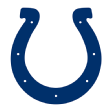
Indianapolis Colts
1. Bring back Pierre Desir and Clayton Geathers. Desir was the standout corner for a surprising Colts defense last season. After losing his job with the Browns amid one of their many regime changes and bouncing around practice squads, he has found a home in Indy over the past two seasons. The Colts let starting corner Rashaan Melvin leave for the Raiders after the 2017 campaign, but I don't think they'll be as comfortable moving on from the 6-foot-1 Desir, whose size will interest teams like the Falcons in free agency. Kyle Fuller picked up a four-year, $56 million offer as a restricted free agent in 2018 after one good season as a corner, and Desir might angle for a similar sort of deal.
Indy will hope to get Desir signed for less than that, and bringing back Geathers would allow the Colts to keep their starting secondary intact. Geathers is a highlight-reel hitter, but the concern is health; the 2015 fourth-rounder has missed 22 games over the past three seasons, mostly with a neck injury. The Colts shouldn't be treating their 2018 team as a precious, irreplaceable group of players, but Geathers is a useful box safety and could even be a hybrid linebacker in nickel packages. If the team does re-sign Geathers, it will likely want to try to build his deal around per-game roster bonuses and prepare for the possibility that Geathers gets hurt during his deal.
General manager Chris Ballard also will have the ability to sort through some of the bargain-bin finds he has made over the past couple of seasons. He already has re-signed Mark Glowinski, but the Colts will have to decide whether they want to bring back veterans such as Margus Hunt, Najee Goode and Dontrelle Inman for 2019 or try to upgrade.
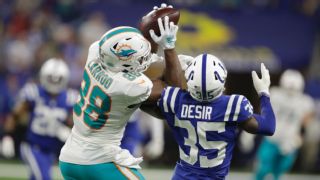
2. Add a difference-maker along the defensive line. The Colts have a lot to be excited about up front. Jabaal Sheard is one of the most underrated two-way ends in the game. Denico Autry broke out in a dramatic three-game stretch during December, racking up six sacks in three games. The Colts bring back a pair of 2018 second-rounders in Tyquan Lewis and Kemoko Turay, with Turay's 13 quarterback knockdowns ranking fourth among rookies.
The Colts ranked 29th in adjusted sack rate last season, though, and if they want to stay committed to defensive coordinator Matt Eberflus' Tampa 2 shell, they need to get consistent pressure with their front four. With three top-60 picks in a draft full of defensive linemen, it wouldn't be a shock if one of those picks went toward a pass-rusher.
I'd also think the Colts will head out to the free-agent market to try to find a veteran. Most of the big names such as DeMarcus Lawrence and Dee Ford are likely going to be kept off the market with franchise tags, but there also will be some big-name players hitting as salary-cap casualties.
Autry found success as a pass-rusher as Indianapolis moved him inside to rush against guards more frequently, but could the team supplement Autry by making a run at an interior disruptor like Gerald McCoy if he is cut by the Buccaneers? Ballard came to Indy from the Chiefs, who are likely to sacrifice Justin Houston to franchise Ford. Houston would have to adjust to having his hand in the ground more frequently, but on pure pass-rushing ability, the Georgia product would be an upgrade and a key part of an edge-rushing rotation.
3. Add help at wide receiver. The Colts were one of the most pass-happy teams in football last season. When the score was within 14 points, Frank Reich's offense threw the ball 64.5 percent of the time, good for the third-highest rate in the league. Only the Steelers (68.4 percent) and Packers (67.0 percent) leaned more heavily toward the pass while games were competitive.
T.Y. Hilton and Eric Ebron got 230 of Indy's 644 pass attempts. Ebron put up a career season, while Hilton missed two games and battled through injuries to excel in December and January. The group of Inman, Ryan Grant, Zach Pascal and Chester Rogers were targeted 201 times, and while Andrew Luck completed more than 68 percent of those throws, he averaged just 6.7 yards per attempt on those targets. Luck averaged 8.8 yards per attempt on his throws to Hilton and Ebron.
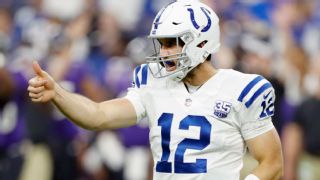
There's an opportunity to add an impact wide receiver, given that the Colts have virtually unlimited cap space; they could bring back Inman after he impressed as a midseason pickup, but the Colts also might find an opportunity to upgrade too. The wideout free-agent class isn't very enticing yet, but imagine this offense with Hilton across from, say, Antonio Brown?
4. Continue to add offensive line depth. For the first time in years, the Colts have an above-average offensive line. Indy has three starters on rookie deals to go with left tackle Anthony Castonzo and right guard Glowinski, who signed a three-year, $16.2 million deal to stay with the Colts in January.
Glowinski took over after veteran Matt Slauson went down with a back injury, and Slauson subsequently decided to retire last month. Jack Mewhort, who had been expected to add depth, unexpectedly retired in August. Indy was able to get by with Joe Haeg, Le'Raven Clark and Evan Boehm as backup linemen, but it needs to keep adding depth to the line, especially at tackle.
5. Pick up Ryan Kelly's fifth-year option. Few Colts took a bigger leap forward in 2018 than Kelly, the final first-round pick under former GM Ryan Grigson's reign. The Alabama product was a difference-maker on the ground, as Indy averaged 4.5 yards per carry and first downs on 25.2 percent of its rush attempts with Kelly on the field, but just 3.6 yards per rush and a 19.8 percent first-down rate with Kelly sidelined.
The 25-year-old suddenly looks like a building block, with injuries as the only notable problem holding him back. He has now missed 13 games over the past two seasons, but the Colts need to pick up Kelly's fifth-year option, despite the injury risk.

Jacksonville Jaguars
1. Designate Blake Bortles as a post-June 1 release. After years of being flush with cap space, the Jaguars find themselves in an unfamiliar place. Tom Coughlin's team is currently at or narrowly over the cap before signing any of its free agents, and it will need to create room to bring in its draft class and upgrade the roster.
To start, it's time for the organization to cut ties with Bortles, who teased Jaguars fans for years but never showed any sort of consistent play suggesting he was a franchise quarterback. The third overall pick in the 2014 draft, Bortles never pieced together six straight games with a QBR over 50 across his 75 games. Jacksonville floated the idea of benching him during the 2017 preseason, only to hand the UCF product a curious extension last offseason.
The most hard-core Jaguars supporters might note that Bortles' decline came after a sterling performance against the Patriots in Week 2, as both his offensive line and tight end room fell apart thanks to injuries, but the time for excuses is over. The past is a sunk cost. There's enough talent to win the division here with an upgrade at quarterback. Finding one won't be hard.
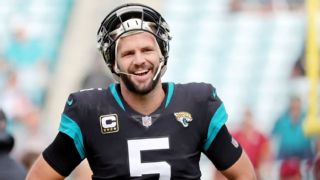
The Jags could have walked away from Bortles scot-free if they hadn't handed the 27-year-old an extension last winter, but they'll need to designate him as a post-June 1 release if they want to cut ties now. Jacksonville will eat a minimum of $10 million in dead money, with $5 million hitting its cap this year and $5 million in 2020.
The Jaguars are temporarily responsible for $6.5 million of Bortles' 2019 base salary, but they should be relieved of some of that burden in free agency by teams targeting Bortles as a backup. It wouldn't be a surprise to see Bortles attract a two-year, $10 million deal from a team such as the Bucs or Cardinals, which would get the Jags off the hook for some of the millions they owe.
Jacksonville should get something in the range of $15 million of salary-cap savings this year, depending on how much of Bortles' base salary is offset elsewhere. Doing that will get the Jags under the cap, but they'll still have more work to do.
2. Move on from Malik Jackson, Carlos Hyde and Austin Seferian-Jenkins. Jackson made his first Pro Bowl in 2017. Twelve months later, Jackson lost his starting job and was buried in the lineup behind 2018 first-rounder Taven Bryan. Jackson averaged 45.5 defensive snaps per game during the first half of the season, but by the final month of the campaign, the former Broncos standout was averaging exactly half that figure. The Jags can free up $11 million by moving on from him.
The trade for Hyde was an ill-fated attempt to find a veteran back to keep the Jags' offense going while Leonard Fournette and Corey Grant were injured. The Jaguars ended up trading a fifth-round pick for a player who carried the ball 58 times for 189 yards. Cutting Hyde generates $4.7 million more of cap space. Seferian-Jenkins got $4 million guaranteed as a free agent last year.
3. Don't do anything drastic at running back. During Dave Caldwell's run as Jags general manager, he has repeatedly attempted to solve his running back conundrum by throwing more and more resources at the position with no viable results. He started by signing Vikings backup Toby Gerhart to a three-year, $10.5 million deal. Gerhart lasted one year as a starter and was out of football by Year 3.
The Jags replaced Gerhart by using the 36th pick in the 2015 draft on T.J. Yeldon, who got one year as the primary starter. During the 2016 offseason, they gave Jets bruiser Chris Ivory a five-year, $32 million deal and had him split time with Yeldon. After Ivory missed five games and fumbled five times on 137 touches, they used the fourth overall pick in the 2017 draft on Fournette.
After two years, the Fournette move isn't looking great. The former LSU star has averaged 3.7 yards per carry and missed chunks of time in each of his first two seasons. The team is reportedly attempting to void the remaining $7.1 million in guaranteed salary on Fournette's deal after he was suspended for fighting Bills defensive end Shaq Lawson in the middle of a truly inconsequential game in November. Jacksonville presumably could cut Fournette and save that $7.1 million if Fournette's appeal does not succeed.
The Jags might be tempted to throw more money or high draft picks at running back to try to find a solution. They need to stop. They are better off hitting 2019 with Fournette and re-signing Grant, who was valuable both as a special-teamer and a receiving back when healthy. If the Jags want to use a midround pick on a back or sign a veteran for less than $2 million in free agency, that's fine. Devoting any serious resources to the position would invoke that famous cliché about the definition of insanity.
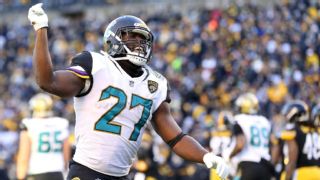
4. Sign Nick Foles or Tyrod Taylor. There aren't any foolproof options in this year's quarterback class, and that was before Joe Flacco was traded. Case Keenum was a Pro Bowler in 2017 and a backup-caliber passer otherwise. Foles is inconsistent, and he struggled mightily outside of the Andy Reid/Doug Pederson cocoon, although John DeFilippo, the Eagles' quarterbacks coach in 2017, is now the offensive coordinator in Jacksonville. Teddy Bridgewater has thrown 25 passes in three years since suffering a catastrophic knee injury. Ryan Tannehill has missed 24 games over the past three seasons. Taylor was a disaster in Cleveland last season.
The Jags could very well fall in love with someone like Ohio State's Dwayne Haskins, but they're in a difficult spot with the No. 7 overall pick. They can't afford to wait things out and trust that the Giants won't take Haskins at No. 6, and if they trade up anywhere short of the first overall pick, the Giants or Raiders might very well beat them to the punch. Moving up from No. 7 to No. 1 would almost certainly cost Jacksonville its 2020 first-round pick, and as its roster gets more expensive, it needs to replenish with cost-controlled talent.
If the Jaguars don't think Haskins is a lock to become a franchise quarterback, they're better off going for one of the two top veterans on the market. Foles has struggled to stay healthy for long stretches of time, but when you include his postseason heroics, he has posted a 64.4 Total QBR across 491 dropbacks since joining the Eagles in 2017. He is pretty clearly the highest-upside option on the market, although his price tag also will be commensurate: It wouldn't be shocking if a Foles deal approached $25 million per season.
Coughlin simply might not be able to devote that much money to the quarterback position, given the rest of Jacksonville's roster. The cheaper option would be to go after Taylor, who fits what Coughlin wants out of his offense. The Jags' avowed game plan is to dominate on defense, run the football and avoid giveaways. Of the quarterbacks on the market, nobody protects the football like Taylor. His career interception rate is 1.5 percent, the second best in NFL history for passers with 1,000 attempts or more. Taylor also has run for 1,700 yards on 299 carries over the past four seasons, which would take some of the workload off whoever ends up as the primary Jags back in 2019. Taylor is not a plug-and-play solution, but he'll play to what Coughlin wants and allow the Jaguars to spend elsewhere.
5. Pick up Jalen Ramsey's option and sign Yannick Ngakoue. Jacksonville should keep around the two best draft picks of Caldwell's reign. The mercurial Ramsey battled through a knee injury during a frustrating 2018 campaign, but he remains one of the best cornerbacks in the league. The Jaguars can pick up his fifth-year option for 2020 and start thinking about an extension for him now.
The only other cornerback to be drafted as a first-round pick under the new CBA and extended after three seasons is Patrick Peterson, and Ramsey is going to get a similar sort of deal. Peterson signed a five-year, $70.1 million extension in 2014, when the cap was at $133 million. Now, with the 2019 cap projected to come in at $190 million, a similarly sized five-year deal for Ramsey would be worth $100 million.
The Jags also will want to start working on an extension for Ngakoue, who has rounded into form as one of the league's best edge rushers. The Maryland product has racked up 29.5 sacks and 10 forced fumbles during his three seasons in the NFL, and while his sack total fell from 12 in 2017 to 9.5 last season, don't think he was slipping. He knocked down opposing quarterbacks 33 times, the third-highest total in the league. Using the 45 percent rule, Ngakoue's knockdown totals should have generated something closer to 15 sacks, suggesting the 23-year-old could take another leap forward in 2019.
The Jags will try to point to the five-year, $72 million deal Danielle Hunter signed with the Vikings last season as an appropriate baseline, given that Hunter was also 23 and had 25.5 sacks after three years in the league. It's not going to work, in part because the resounding sentiment around the NFL after the Hunter deal was that the Vikings had managed to extract a discount. Ngakoue is going to get something closer to five years and $90 million to stick around.
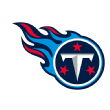
Tennessee Titans
1. Cut Johnathan Cyprien. The Titans have gotten little out of Cyprien, who was inconsistent as a four-year starter in Jacksonville before missing 22 of his first 32 games in Tennessee. The team might prefer to bring back Kenny Vaccaro or address strong safety in the draft, but Tennessee can do better than paying Cyprien a $5.5 million base salary in 2019. Parting ways with the 2013 second-round pick would save $5.3 million.
2. Pick up Jack Conklin's fifth-year option. After tearing his ACL in January 2018 during Tennessee's playoff loss in New England, the right tackle had an uneven third season. The 2016 first-rounder missed the first three games of the season rehabbing the knee, went down for one game with a concussion and then sat out the final three contests of the season with knee issues.
It's natural to be concerned about Conklin's knee, but the Titans have to pick up his fifth-year option and hope the 24-year-old will look like his usual self in 2019, another year removed from the injury. Most offensive linemen are able to recover from ACL injuries without missing much, so unless there are complications we don't know about, the Titans should still consider Conklin to be an essential part of their future.

3. Add edge-rushing help. Both Derrick Morgan and Brian Orakpo are free agents, and while GM Jon Robinson knew this day was coming, the preparations haven't gone as planned. Kevin Dodd, a second-round pick in 2016, was cut after two anonymous seasons in Tennessee and is out of football. Meanwhile, 2018 second-rounder Harold Landry had 4.5 sacks in his rookie season. Landry showed promise, but relying on him to be the primary pass-rusher would be aggressive.
The natural thing would be to look at what's going on with the Patriots, but I wonder whether the 270-pound Trey Flowers might be too big to play as a 3-4 outside linebacker in Mike Vrabel's defense. In a draft full of front-seven help, the Titans seem likely to address the edge with the 19th pick. Rashaan Evans, a first-round pick last year, also will likely see some reps on the outside as well, although his best role is alongside Jayon Brown on the interior.
4. Be realistic about Marcus Mariota. We've seen Mariota play four seasons as a pro quarterback. What we know is ... well, not much. He is capable of great plays and has a knack for big conversions in the fourth quarter, but there also are games in which he looks out of sorts from the start. Mariota struggles with turnovers, as the Oregon product has a below-average interception rate and nine or more fumbles in three of his four seasons. He is on his fifth offensive coordinator in five seasons, after Matt LaFleur left for the Packers, and you might argue that none of those five coordinators has built an offense that actually plays to his strengths.
What you can say with the utmost confidence, though, is that it's difficult to count on Mariota to stay healthy for all 16 games. He has yet to do it as a pro, suffering a meaningful injury each year, though he has missed only eight games across four seasons. In 2015, it was MCL sprains on both of his knees. In 2016, he fractured his right fibula in Week 16. In 2017, he got by with a mere hamstring strain. But last season, the 2015 No. 2 overall pick struggled with neck, elbow and nerve injuries, with a stinger eventually keeping him out of Tennessee's must-win game vs. the Colts in Week 17.
At this point, expecting Mariota, who will be an unrestricted free agent in 2020, to suddenly play 16 games in a row for years at a time is naive. The Titans have to treat the backup quarterback spot less like a fallback plan and more like an inevitability. They need to pay a premium and go after someone they're more confident in for two or three starts per year than Matt Cassel or Blaine Gabbert, who is under contract with the Titans for 2019.
There are free agents who represent a match for Mariota's mobility in Tyrod Taylor and Robert Griffin III, but given that the Titans haven't really built their offense around that mobility, they don't necessarily need a quarterback who is comfortable running the read-option. I wonder whether there might be a fit with Ryan Fitzpatrick, who was Tennessee's starting quarterback in 2011 and would qualify as one of the better backups in football. If the game of musical chairs ends with Keenum out of a starting job, the Titans would do well to pay a premium to bring him to Nashville.
5. Extend Kevin Byard. While the free safety was never going to keep up his eight-interception pace from 2017, he had every bit as good of a season in 2018 as the one that got him an All-Pro nod two years ago. He didn't get the same recognition because he picked off "only" four passes, but that's the reality of how voters perceive interception totals as driven by defensive backs when the cause can more often be quarterbacks. The 2016 third-round pick chipped in with two sacks and also threw a 66-yard touchdown pass to Dane Cruikshank when the Texans forgot to cover the Titans' gunner in Week 2.
Byard is a free agent in 2020, and while the Titans could choose to go year to year and use the franchise tag on him, Robinson might understandably want to reward one of his best draft picks since joining the organization. The two sides should eventually come to terms on a deal with an average annual salary of about $10 million.
AFC WEST
Let's begin this week with the AFC West, where the Broncos already kicked off the player-acquisition window by reportedly trading for their new starting quarterback ...

Denver Broncos
1. Cut Case Keenum and Emmanuel Sanders. Realistically, there isn't going to be a trade market for Denver's 2018 starting quarterback given his $18 million base salary, $7 million of which is already guaranteed. Likewise, there's no credible scenario in which the Broncos keep the 31-year-old Keenum with a $21 million cap hit behind Joe Flacco. Denver would eat a $10 million dead cap charge by releasing Keenum, but it would free up $11 million in badly needed cap space in the process.
The Broncos can create more room by moving on from their veteran receiver. Sanders returned to form last season and was averaging 72.3 receiving yards per game, but after tearing an Achilles in December, he might not be ready to start the season on the active roster. The team can cut the soon-to-be 32-year-old and free up $10.3 million more in space. After declining linebacker Brandon Marshall's option, these two moves would get the Broncos to $44.5 million in cap space.
2. Bring back Matt Paradis. This offensive line has been a mess for years, but the one bright spot has been the development of Paradis, who redshirted after being drafted in the sixth round in 2014 before starting 57 consecutive games. He missed the final seven games of last season with a fractured fibula, and while he should be healthy to start 2019, the Broncos don't yet have their star center under contract.
The franchise tag might not apply here, thanks to a rule structure that hasn't caught up with how teams value players. The NFL makes only one offensive lineman tag value available, and despite the fact that left tackles get paid more than linemen elsewhere along the line, the tag value for guards and centers is based on top-tier blindside protectors.
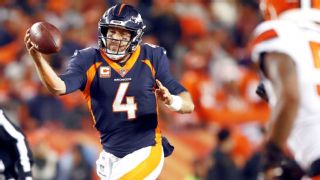
CBS Sports' Joel Corry projects that the 2019 tag for offensive linemen will come in at $14.2 million, which is an exorbitant sum considering that the largest annual average salary for any center in the league is Tampa's Ryan Jensen at $10.5 million. Paradis is also hitting the market at age 29, making him older than most typical first-time free agents. You can understand why he might also want to avoid the franchise tag. This is his best -- and possibly only -- chance at making life-changing guaranteed money.
In a league desperate for competent line play, though, Paradis is going to have a serious market. Jensen was three years younger than Paradis when he entered free agency, but he got a four-year, $42 million deal after just one year as a starting center. Paradis is likely to get a similar deal; it wouldn't be a surprise if he picked up a four-year, $44 million pact.
3. Work on bringing back Bradley Roby. A rare hit for GM John Elway in the first round of the draft, Roby excelled as Denver's third cornerback behind Aqib Talib and Chris Harris Jr., only to struggle last season after Talib left for the Rams. Roby is an unrestricted free agent, but the Broncos don't really have anyone to take his place in the lineup; Tramaine Brock is also a free agent, and third-round pick Isaac Yiadom played like a rookie in limited time. If no team blows away Roby with an offer -- which is entirely plausible given what we saw last season -- the Broncos should trust their first four seasons with Roby over an uneven 2018.
4. Add a weapon at tight end. Jeff Heuerman is a free agent, and while the Broncos were hoping that Jake Butt would give them an athletic tight end, Butt tore an ACL for the third time in practice last September. Knee injuries have limited the former Michigan man to three NFL games in two seasons. Troy Fumagalli, a fifth-round draft pick last year, spent all of his rookie season on injured reserve.
With the Broncos trading Demaryius Thomas and likely moving on from Sanders, they need to get more out of their tight end group as receivers. In a draft rich with tight ends, they have to consider using their second- or third-round pick on a weapon for Flacco. They also could be in the discussion for possible cap casualties such as Kyle Rudolph and Cameron Brate.
5. Resist the urge to go after a quarterback and draft front-seven help. While there were reports that Elway was infatuated with 6-foot-4 Missouri quarterback Drew Lock before the Flacco trade, Lock is the exact sort of big-bodied, inaccurate passer Elway has failed with over the past few seasons. Flacco is not a long-term solution, but unless Dwayne Haskins or Kyler Murray slips to the Broncos at No. 10 overall, Denver won't be in position to take a franchise quarterback.
Instead, the Broncos should replenish a run defense that ranked 16th in defensive DVOA a year ago. (Denver was fourth, in comparison, against the pass.) The Broncos are set on the edge with Bradley Chubb and Von Miller, but backups Shaquil Barrett and Shane Ray are free agents, so using a midround pick on the edge might make sense. The more obvious concern would be at the nose, where Domata Peko is an unrestricted free agent and Shelby Harris is a restricted free agent. The Broncos also could stand to add depth behind Derek Wolfe, who just completed his first 16-game season since 2014.

Kansas City Chiefs
1. Franchise Dee Ford. The Chiefs can't afford to lose their best pass-rusher. Ford has 25 sacks in 37 games since becoming a full-time starter in 2016, and while he won't force seven fumbles again in 2019, he's a building block for this defense. Kansas City might start with the franchise tag, but Ford and the Chiefs likely should come to terms on an extension in the five-year, $90 million range by the end of the offseason.
2. Release Justin Houston. Ford's franchise tag would cost about $17.9 million and bring the Chiefs below $8 million in cap space. That's not enough given the other moves the Chiefs have to make, and the most obvious candidate to hit the street is Kansas City's other edge rusher. Houston signed a six-year, $101 million extension after a 22-sack season in 2014, but injuries have limited the Georgia product to 30 sacks over the ensuing four seasons. The team would free up $14 million in cap space by moving on from the 30-year-old Houston. Kansas City might get lucky and convince Houston to restructure his deal, but there's no way he can return in 2019 on a cap hit north of $20 million.
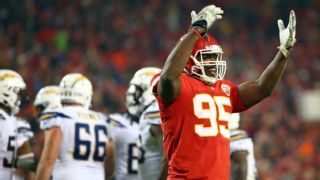
3. Work on a new deal for Chris Jones. The Chiefs also need to find the cap room to work on an extension for Jones, who enters the final season of his rookie contract in 2019. He is set to make only a $1.2 million base salary as part of a cap hit under $2 million, but the team can't plan on having the franchise tag available for Jones in 2020 for reasons I'll get to in a minute.
Jones was inconsistent during his college career and disappointed during his second pro campaign before delivering a 15.5-sack campaign for the Chiefs last season. They have to be at least a little reticent about handing him an extension, but he is too good of a player when he's on for the team to let him leave. The timing of the extension depends on another member of Kansas City's 2016 draft class ...
4. Or work on an extension for Tyreek Hill. If Kansas City can lock up Ford and sign either Jones or Hill to an extension this offseason, it can hold the franchise tag in wait for the other player next offseason. If not, the Chiefs run the risk of letting either Jones or Hill leave in free agency next March.
On paper, the Chiefs probably would prefer to extend Jones and leave Hill's rookie deal in place for one more season for financial reasons; Hill's fifth-round rookie contract is far cheaper than Jones', and the star wideout is going to net a much larger extension when the two sides do come to terms. You might make the case that the Chiefs should lock up Hill instead because he has been the more consistent player; Jones might not attract quite as large of a deal if he takes a step backward in 2019.
In terms of his on-field performance, Hill compares favorably to the other star wideouts who have signed extensions over the past couple of seasons. His numbers over his second and third seasons are similar to those of the league's other top young receivers over their same seasons, but he needs fewer touches as a receiver to rack up yardage, as you can see from the yards-per-target category:
Those stats don't include Hill's work as a runner (210 yards and a touchdown the past two seasons) or what he has done as arguably the league's best return man, with five return touchdowns in his first three seasons. It wouldn't be a surprise if Hill's next deal tops the five-year, $90 million extension Odell Beckham Jr. signed in August.
5. Find a new center. Coach Andy Reid has generally let his interior linemen leave in free agency, trusting that offensive line coach Andy Heck can mold castoffs or late-round picks into useful starters. When Rodney Hudson hit free agency four years ago, the Chiefs let him leave for the division rival Raiders, drafted Missouri tackle Mitch Morse, and moved him inside to take over as their starting center.
After 49 starts, the cycle will begin anew. Morse likely will leave for a big deal in free agency, and the Chiefs will get creative. Kansas City could hand the job to Austin Reiter, who started when Morse missed five games with a concussion. They could move former Browns center Cameron Erving from guard back to the pivot, where the first-round pick played during his final season at Florida State. Most plausibly, the Chiefs will draft someone in the middle rounds and Heck will turn him into a viable starter.

Los Angeles Chargers
1. Work on a deal with Denzel Perryman. Two oft-injured defensive stars hit free agency this offseason for the Chargers. It's probably time to move on from star-crossed corner Jason Verrett, who has played just five games over the past three seasons since making the Pro Bowl in 2015. Even if they do want to bring back Verrett, it's hard to imagine him getting much more than the veteran minimum.
Perryman makes for a more difficult case. The former Miami product hasn't had a Verrett-sized injury history, but the Chargers' inside linebacker has missed 22 games in his first four seasons, including 16 in the past two years with knee, hamstring and ankle injuries. In the past four years, the Chargers have allowed a 53 Total QBR and an 88.9 passer rating with Perryman sidelined, but a 41.6 Total QBR and an 80.6 rating with Perryman on the field. The effect is more pronounced on the ground, where the defense allowed 4.7 yards per carry with Perryman off the field and 4.0 yards per rush with their former second-round pick on it.
I don't know how Perryman is valued given the injury history, but he's a helpful player for this defense. The Chargers ended the year playing safeties at inside linebacker in the postseason after Perryman and Jatavis Brown went down, and they might prefer a fresh start at the position. Some team is going to take the plunge on Perryman, and if he can stay healthy -- a huge "if" -- it is going to have an excellent football player on its hands. A deal with significant per-game roster bonuses would make sense if Perryman wants to return to Los Angeles.
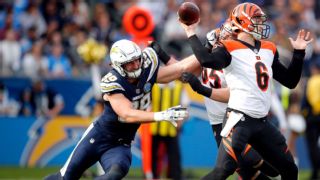
2. Pick up Joey Bosa's fifth-year option. This is an easy call, as the only thing that has managed to stop the 2016 third overall pick has been his own health. The pass-rusher missed the first four games of his rookie season with a hamstring injury, then sat out the first half of the 2018 season while recovering from a foot injury. Bosa otherwise has 28.5 sacks in 35 career games, roughly a 13-sack rate over a full 16-game season.
The Chargers could consider working on an extension with Bosa, given that they might be buying low after a half-season. The only other first-round edge rushers to get an extension after three years under the current CBA are J.J. Watt and Robert Quinn. Los Angeles could go year by year with him and get his next three seasons for something slightly south of $40 million, which is far below his market value over that time frame. It's more likely that the two sides will find mutual ground on an extension next offseason.
3. Extend Philip Rivers. The fiery 37-year-old Rivers has shown little sign of slowing down, as he posted a 105.5 passer rating in 2018, which is tied for the best single-season mark in his career. (He posted a 105.5 passer rating in 2008, 2013 and 2018, so get ready for a 42-year-old Rivers to run roughshod on the AFC West again in 2023.) Rivers has said that he has no desire to play into his mid-40s, but on a championship-caliber team, it seems fair to believe that he has a couple of more years left in that right arm.
With Rivers entering the final year of the four-year, $83.3 million extension he signed in August 2015, it makes sense for the Chargers to try to tack on a two-year extension to get him to his age-40 campaign. Drew Brees signed a two-year, $50 million extension before the final season of his deal with the Saints last March; given a likely rise in the cap, a two-year, $54 million pact would make sense.
4. Add defensive line help. The Chargers have a lot of work to do up front, as 34-year-old nose tackle Brandon Mebane is a free agent, while L.A. declined the option on Corey Liuget, who started the 2018 season suspended and ended it on injured reserve with a torn hamstring. Throw in Darius Philon and Damion Square, both of whom are free agents, and the Chargers have to find players to make up more than 1,700 missing defensive snaps in 2019.
The decision to decline Liuget's option freed up $9.5 million of cap space, and it wouldn't be a surprise if the Chargers used some of that money to re-sign Philon, who started 13 games and chipped in with four sacks and nine quarterback knockdowns a year ago. L.A. could certainly look toward a deep draft for defensive linemen, but it also wouldn't be surprising to see the team pursue veteran help. Defensive coordinator Gus Bradley could put a word in for Malik Jackson if his former charge in Jacksonville is a cap casualty.
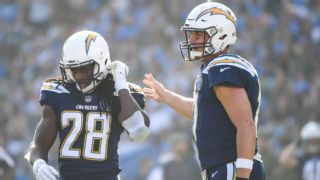
5. Don't sign Melvin Gordon to an extension. The running back is entering the fifth-year option of his rookie deal at $5.6 million. Gordon has been an asset to fantasy teams, scoring 38 touchdowns over the past three seasons. After fumbling six times on 217 touches as a rookie, he has responded by fumbling just four times on 862 touches over the ensuing three campaigns. His ability with the football makes him a three-down back, and he had his best season as a runner in 2018.
All of those things are true, but the Chargers have to give serious thought to letting Gordon leave after the 2019 season. For one, there are concerns about paying any veteran running back significant money after his rookie deal. Gordon doesn't have as many carries as other backs after their first four seasons, but that's because he has already struggled to stay healthy; he has completed just one 16-game season and missed nine games in four campaigns. Gordon has suffered knee injuries in three different years in addition to a 2016 hip sprain and a 2018 hamstring issue.
His on-field play hasn't been quite as impressive as those fantasy totals, either. Gordon's 28 rushing touchdowns have been the product of sheer volume near the goal line. He has 39 carries inside the 5-yard line in the past three seasons. Backs score on 41.8 percent of those carries, which would suggest Gordon should have scored 16.3 touchdowns on those rushes. He actually scored 18, which amounts to about one extra touchdown every two seasons, and that's without including his zero-touchdown season in 2015.
The former Wisconsin star doesn't have the cumulative numbers we would expect from a star back because of the injuries. He also hasn't been all that efficient on a per-carry basis. Here's Gordon's rank in yards per carry and expected point success rate (EPA+%), which measures how frequently a back's carries increase his team's chances of scoring, among backs with 150 carries or more in each of his four seasons:
In Gordon's four pro seasons, 19 backs have racked up 600 carries or more. Gordon ranks 11th in yards per attempt (4.0) and eighth in success rate (38.5 percent). He has been about a league-average back when healthy, and he hasn't been healthy for extended stretches of time. Gordon is unquestionably talented, but if he's looking for a Devonta Freeman-sized deal -- let alone something in the Le'Veon Bell or Todd Gurley ballpark -- the Chargers are probably better off drafting his replacement and letting him leave.

Oakland Raiders
1. Trade Jordy Nelson. The experiment to bring in the 33-year-old Nelson didn't really take, as the longtime Packers standout caught 63 passes for 739 yards and three scores in a relatively anonymous 2018 campaign. Nelson still has something to offer, but he's of little use to a rebuilding Raiders team, something Jon Gruden should have realized before signing Nelson last offseason.
Nelson has only $3.6 million remaining on his deal for 2019, making him a modestly valuable asset as a WR2/WR3 in a market with little in the way of wide receiver help available. The Kansas State product might appeal to teams that strike out in free agency and don't love this year's draft class. Teams such as the Colts, Patriots and Cowboys could justify trading a fifth- or sixth-round pick for one year from Nelson. A Packers reunion might also make sense for both sides.
2. Don't sell off the offensive line. After trading away Khalil Mack and Amari Cooper last offseason, it might be tempting to continue the fire sale and trade away whatever isn't nailed down. If the Raiders had many veterans of interest beyond Nelson, it might make sense to put them on the market.

The one group I would hold onto in a rebuild, though, is Oakland's expensively assembled offensive line. The Raiders likely will move on from 35-year-old tackle Donald Penn, but their interior three of Kelechi Osemele, Rodney Hudson and Gabe Jackson shouldn't hit the market. Having a sound offensive line allows Gruden the best opportunity with which to evaluate Derek Carr and will make life easier for Oakland's next quarterback if Gruden decides to replace his 27-year-old starter. The Browns let Mitchell Schwartz leave in free agency and lost Alex Mack to the Falcons during their tanking phase, and they ended up paying for lesser veterans to replace their two future All-Pro linemen. The Raiders shouldn't make the same mistake.
3. Sit out unrestricted free agency (mostly). One thing I would follow from the Browns, though, is to avoid wasting time signing midtier free agents while blowing compensatory picks in the process. The Raiders could get a high comp pick for free-agent tight end Jared Cook, who had an outlier season in terms of touches and production last season and isn't likely to get better after turning 32 in April. They shouldn't waste that pick just to sign a player who won't help their long-term outlook.
4. Open for business if you don't like a quarterback with the No. 4 overall pick. The Raiders are in a bind. Oakland is the first team in this draft that is giving serious consideration to using its first-round pick on a quarterback. The Raiders also pick fourth behind the Cardinals, 49ers and Jets, each of whom could theoretically trade down with a team trying to move up and grab Dwayne Haskins or Kyler Murray. If a team loves one of those passers, it knows it will have to get ahead of Oakland.
If Oakland doesn't love these quarterbacks and wants to go another 16 games with Carr, it should turn the fourth pick into a trade asset. This roster is too thin to turn down any meaningful trade-down opportunities, and if a team like the Dolphins (No. 13) or the Redskins (No. 15) wants to get ahead of the Giants at No. 6, the Raiders should be able to pick up an extra first-round pick in the process. It means they will miss out on their best chance of adding elite talent with the fourth pick, but this team needs good young players at just about every single position.
5. Draft the best available player. Over and over again. Gruden's rebuild has left the Raiders with a promising offensive line, some players to hope upon in the secondary, and useful depth at defensive tackle, plus whatever you might think about Carr. The Raiders are in no position to be turning down talent at any position. In a draft full of front-seven pieces, offensive linemen and tight ends, Oakland should simply be trading down or picking the best players on its board.

